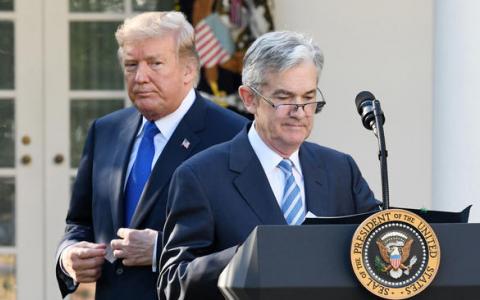
(MarketWatch) Fed Chair Jerome Powell doesn’t know the answer, he knows he doesn’t know, and he knows you know he doesn’t know. So quit asking it.
“It” of course is the trillion-dollar question (and its many permutations) that everyone on Wall Street, on Main Street, and in Washington is asking: What’s happening in the economy? Is a recession coming? Will the Fed cut rates in time? Should I buy or sell? Should I refinance? Should I expand my business? Will the trade war blow over?
And so when the Fed released its latest forecasts on Wednesday, everyone rushed to look at the dot plot to see if the Fed was going to cut rates again in December. The answer was no, and everybody got sad.
But that’s the wrong response, because as I said, Powell doesn’t know the answer.
Forward guidance
For nearly two decades, the Federal Reserve has tried to be as predictable as possible, on the theory that the best way to conduct monetary policy is to give everybody a road map to where the Fed is likely heading. Forward guidance would let investors, traders, businesses and consumers set their expectations about monetary policy, and that would keep the economy humming along.
Except in emergencies, the Fed’s policy was to never surprise the markets. For much of the tepid expansion, the Fed’s message was: We promise to keep interest rates low for a very long time. They published a “dot plot” to illustrate that commitment to keep rates low.
And then, once they began tightening, their message was: We will raise rates very gradually. And the dot plot helped them communicate that.
But once the Fed started to ease rates again, the strategy of forward guidance became a liability to the Fed. The dot plot now does more harm than good.
Put no stock in our forecasts
On Wednesday, Powell all but declared forward guidance dead.
Don’t pay any attention to our forecasts, he seemed to be saying, because we really don’t know what will happen next. We have no faith in our forecasts, and neither should you.
You can’t give meaningful forward guidance if you do not know which way you are going to turn. Powell promised the Fed would remain vigilant and would try to steer the economy out of trouble, but he couldn’t say whether trouble would come, or when.
Powell said that the Fed can do a lot to support the economy, but it cannot do the one thing that is needed right now: Supply a “settled roadmap for international trade.” Only President Donald Trump can tell businesses what the rules are. Only Trump can create certainty.
Not knowing if or when the trade chaos will be resolved means that everyone’s forecasts become less valuable. Beyond the direct hit from higher tariffs, the trade war also means businesses don’t know what the rules will be next year, or next week. There’s a huge unknown in the equation that’s depressing investment.
"What the Fed needs to convey now is not a roadmap to the future, but a credible promise that it will take the right steps, whatever happens."
All 17 members of the Federal Open Market Committee are optimistic that a recession can be avoided. About half of the committee think one more rate cut may be needed, but none of them are willing to go public with a forecast for more aggressive easing, even though each of them knows that further cuts might become necessary.
None of them have much confidence in those forecasts. There are too many unknowns to predict anything with confidence. What the Fed needs to convey now is not a roadmap to the future, but a credible promise that it will take the right steps, whatever happens.
Given past failures, that’s a hard message to sell. The one thing the Fed has going for it right now is humility. Powell knows that he does not control events; he can only react.
Good luck!



